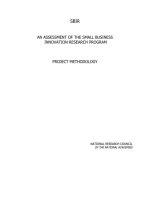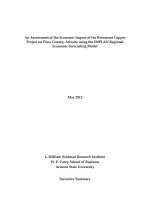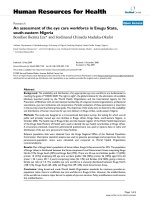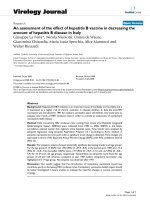an assessment of the translation of the witches
Bạn đang xem bản rút gọn của tài liệu. Xem và tải ngay bản đầy đủ của tài liệu tại đây (7.86 MB, 17 trang )
<span class="text_page_counter">Trang 1</span><div class="page_container" data-page="1">
<b>ENGLISH DEPARTMENT ---o0o--- </b>
<b>AN ASSESSMENT OF THE TRANSLATION OF <THE WITCHES= </b>
<b>By NGUYEN THI BICH NGA</b>
<b>STUDENT’S CODE: A35724 </b>
<b>HANOI, OCTOBER 2021 </b>
</div><span class="text_page_counter">Trang 2</span><div class="page_container" data-page="2"><b>6. Newmark’s model of translation quality assessment ... 3 </b>
<b>CHAPTER 2: AN ASSESSMENT OF THE </b>TRANSLATION OF <THE WITCHES=<b> .... 4 </b>
<b>1. Text analysis ... 4 </b>
<b>2. The translator’s purpose ... 4 </b>
<b>3. Comparing the translation with the original ... 5 </b>
</div><span class="text_page_counter">Trang 3</span><div class="page_container" data-page="3">1
<b>INTRODUCTION </b>
Translation is a difficult and complicated area. It is required that translators have to take full advantage of 4 basic skill: Listening, Speaking, Reading, Writing, along with a wide range of vocabulary and the ability to use language flexibly and accurately which not every language learner could do. Besides, different translators could make different translations from one source language text. The reason is that they can apply different translation methods for their translations which lead to inconsistencies in the translated or target document, and it might possibly result in many arguments about whether is a good translation. Therefore, in the area of translation studies, translation quality assessment has played an important role in recent times. Moreover, according to Peter Newmark: <Translation criticism is an essential component in a translation course: firstly, because it painlessly improves your competence as a translator; secondly, because it expands your knowledge and understanding of your own and the foreign language, as well as perhaps of the topic; thirdly, because, in presenting you with options, it will help you to sort out your ideas about translation=.
In this essay, I would like to introduce Newmark9s model of translation quality assessment (TQA) and apply Newmark9s model to assessing the translation of the first chapter of <The Witches= by writer Roald Dahl. My reason for choosing this translation (by Nguyen Thi Bich Nga) is first, it has always been a great story in my heart since I was a little child. His writing style is very unique and has a strong impression on me. His stories always have elements and characters that are strange and unreal; however, I do not think there is a child who does not believe in those stories. Secondly, this translation of the first chapter has an ideal length for my essay since the framework and the time is not allowed me to choose a longer source language (SL) text and target language (TL) text. Finally, I love the way Roald Dahl used words in his story that made his story sound interesting, mysterious and also created a curiosity in our little children. Moreover, it is also a hard work for any translators who translated his story because of his word usage since he used a lot of cultural and <untranslatable= words. Therefore, by choosing the translation of <The Witches=, I believe that there are so many knowledges I can gain from and skills that I can improve for myself.
Through this assessment, it is expected that I can understand thoroughly and explain the primary theories of Translation which support for Newmark9s model of TQA and be able to apply his model to analyzing and assessing the translation of the first chapter of <The Witches= by Nguyen Thi Bich Nga.
</div><span class="text_page_counter">Trang 4</span><div class="page_container" data-page="4">2
<b>CHAPTER 1: THEORETICAL FRAMEWORK </b>
In this chapter, I would like to present some primary theories of translation, translation methods, equivalence in translation and translation errors along with Newmark9s model of TQA.
<b>1. Translation </b>
According to Peter Newmark9s <A textbook of translation=, 8translation is rendering the meaning of a text into another language in the way that the author intended the text . While in 9 one his other book <Approaches to Translation=, he defined 8translation is a craft consisting in the attempt to replace a written message and/or statement in one language by the same message and/or statement in another language . 9
<b>2. Text analysis </b>
Regarding to Christiane Nord, <text analysis provides a reliable foundation for each and every decision which the translator has to make in a particular translation process=. Text analysis including the author9s purpose, the translator9s intention, characterization of the readership; an indication of its category and type (Peter Newmark).
<b>3. Translation methods </b>
<i>3.1. Semantic translation </i>
'Semantic translation attempts to render the exact contextual meaning of the original as closely as the semantic and syntactic structures of the second language allow,' according to Newmark Semantic translation is biased toward the source language; it is literal, and it is devoted to the author of the ST It is readable, yet it adheres to the original culture and only supports the reader in its connotations if they are vital to the text's content. It is more complicated, awkward, and detailed than the original, and it tends to overtranslate - it is more specific in conveying nuances of meaning than the original.
<i>3.2. Communicative translation </i>
8Communicative translation attempts to produce on its readers an effect as close as possible to that obtained on the readers of the original9 (Newmark). Opposite to semantic translation, communicative translation has a target language bias; it is free and idiomatic. It prioritizes intelligibility and naturalness. This translation method attempts to make the reading process easier for the TL reader. It must focus on the message's impact rather than its content. It is likely to be smoother, simpler, clearer, more direct, and tending to undertranslate.
<b>4. Equivalence in translation </b>
Equivalence in translation is still a controversy in the area of translation study. Equivalence in translation can be understand as a relationship between SL text and TL text. In an attempt to answer the question of what is equivalent to what, Koller distinguishes five different types of equivalence: denotative equivalence involving the extralinguistic content of a text, connotative equivalence relating to lexical choices, text-normative equivalence relating to text-types, pragmatic equivalence involving the receiver of the text or message, and, finally, formal equivalence relating to the form and aesthetics of the text (Despoina Panou).
</div><span class="text_page_counter">Trang 5</span><div class="page_container" data-page="5">3
<b>5. Translation errors </b>
Errors in translation mostly result from the 8a non-equivalence between the source and target languages9 (Baker). It can indicate the quality of a translation as well as reveal the translator9s linguistic knowledge of both the source and target languages. Translation errors can have a negative impact on a translation as it might make it difficult for the reader to understand the content of the text. According to American Translation Association, translation errors can be divided into 4 categories which are linguistic errors, comprehension errors, translation errors and formatting errors.
<b>6. </b>Newmark’s model of <b>translation quality assessment </b>
Translation quality assessment is an essential link between translation theory and its practice (Newmark). We can use TQA model to evaluate quality of a translation. The model of translation quality assessment of Newmark has 5 steps: (1) an analysis of SL text, (2) The translator9s interpretation of the SL text9s purpose, (3) a detail comparison of the translation with the original, (4) an evaluation of the translation, and the final step is (5) an assessment of the work9s potential importance within the target language culture.
</div><span class="text_page_counter">Trang 6</span><div class="page_container" data-page="6">4
<b>CHAPTER 2: AN ASSESSMENT OF THE TRANSLATION OF <THE WITCHES= </b>
This chapter will present the application of Newmark9s TQA model to assess the quality of the TL text in the first chapter of <The Witches= by Nguyen Thi Bich Nga.
<b>1. Text analysis </b>
<The Witches= is a fantasy book written for children by the British writer Roald Dahl. The book was originally published in 1983 by Jonathan Cape in London, with illustrations by Quentin Blake. In the year when it was published, the book received several awards and it was one of the top all-time children9s novels. <The Witches= is the story about a 7-year-old boy living with his Norwegian grandmother after his parents had died in a tragic car accident and his battle with a society of evil witches whose have a great hatred toward children. The chapter chosen for this essay is the first chapter <A Note about Witches and it was an introduction about witches. = <Phù thủy, phù thủy= is the Vietnamese version translated by Nguyen Thi Bich Nga. It was first published in Vietnam by Kim Dong Publishing House in 2005. Nguyen Thi Bich Nga is also the translator for several other Roald Dahl9s books published in Vietnam.
The first chapter of the book which is <A Note about Witches=, is a brief introduction about witches. In my opinion, Roald Dahl9s intention in this chapter is to grab readers attention and gradually raise a curiosity and interesting feelings in readers especially children about the world of ordinary people living with a secret society of child-hating witches. Additionally, it can be seen that the intention of translator while translating this story is the same as the author. Besides, the text types of the first chapter as well as of the whole book is narrative. The book was written in the first-person perspective and narrated by the main character. The story was written in informal and colloquial styles and was particularly aimed at children; however, at that time, it sparked a lot of controversy because the <child-hate= attitude of his characters along with some frightening scene that might not suitable for children. Moreover, perhaps, this is the reason why some phrases and words in the SL text was omitted or changed into other words by the translator Nguyen Thi Bich Nga in the Vietnamese version of the book <Phù thủy, phù thủy=. Furthermore, the background of the story is very interesting. As I have read about it on the website of his own, Roald Dahl wrote this story based on his childhood experiences. When he was a child, Roald Dahl used to spend every summer holiday with his family in Norway, and at that time, he was inspired by bedtime stories about the world of magic and witches. It is also said the character of the grandmother actually modeled after Sofie Dahl, the author9s mother.
<b>2. The translator’s purpose </b>
After reading both the original version by Roald Dahl and the translated version by Nguyen Thi Bich Nga, it is noticeable that the intention of the translator is identical with writer9s intention, although there are some changes in the translated version. Moreover, the fun and humorous writing style along with the unique way of using comparison of writer Roald Dahl were remained when the SL text was translated into TL text. At the same time, translator Nguyen Thi Bich Nga9s translated version <Phù thủy, phù thủy= is intelligible and suitable for readers at a young age as kids.
</div><span class="text_page_counter">Trang 7</span><div class="page_container" data-page="7">5
translation method and communicative translation method. In addition, in my opinion, to adapt well with readers at a young age as well as to fitting into Vietnamese cultural, translator Nguyen Thi Bich Nga had omitted and changed some phrases and parts of the original story. However, there are some parts omitted or changed that I personally think they are not really necessary and this issue will be analyzed in the next part.
<b>3. Comparing the translation with the original </b>
The translation used to compare is chapter one of the book which consists of 5 pages, from pages 5 to 9. Meanwhile, the original text includes 5 pages, from pages 7 to 11. In the framework of this essay, I will compare the translation with the original in page order print.
1 Tên truy n ệ Phù th y, phù th y ủ ủ <sup>Book9s </sup>
title <sup>The Witches </sup>
bao gi quên các chi ti t này. ờ ế
Listen very carefully. Never forget what is coming next.
5 (Khơng có trong b n d ch) ả ị red-hot sizz-ling
8
Trang 6
9 (Khơng có trong b n d ch) ả ị <sup>and she could be doing any of </sup> these things
whizzing and phizzing 11 những tư tưởng cực kì kinh khiếp murderous bloodthirsty thoughts 12 <sup>Suốt ngày bà ta cứ lẩm bẩm thầm </sup>
trong b ng ụ
Page 8
she says to herself all day long 13 (Khơng có trong b n d ch) ả ị "Which child,"
14 cho l n theo dõi k ti p ầ ế ế for my next squelching 15 khi theo dõi một đứa tr ẻ from squelching a child
17 <sup>Theo ch </sup>ỉ tiêu đó, trong một năm bà ta ph i cho bi n mả ế ất 52 đứa tr . ẻ
One child a week is fifty-two a year.
18 (Khơng có trong b n d ch) ả ị <sup>Squish them and squiggle them </sup> and make them disappear
</div><span class="text_page_counter">Trang 8</span><div class="page_container" data-page="8">Tia sáng nháy lên. L a ph t ra. ử ụ Dầu sơi sùng sục. Chuột rúc chút chít. Da n i gai ổ ốc. Và đứa tr ẻ biến mất.
Page 9
Sparks fly. Flames leap. Oil boils. Rats howl. Skin shrivels. And the child disappears.
22 <sup>nhiều mưu ma chước quỷ nhảy </sup>
múa tưng tưng trong máu bà ta <sup>devilry dancing in her blood </sup> 23 Nhưng vẫn đủ nhiều để làm các
bạn căng thẳng.
But there are still quite enough to make you nervous
32 (Khơng có trong b n d ch) ả ị and this will make you jump 33 Nhưng điều có thể đốn được
cũng có thể ảy ra đượ x c!
Page 11
But - and here comes the big "but" - it is not impossible.
34 (Khơng có trong b n d ch) ả ị <sup>then we could round them all up </sup> and put them in the meat-grinder.
35 (Khơng có trong b n d ch) ả ị
little quirky habits that all witches have in common, and if you know about these, if you remember them always,
37
Biết được thói quen của họ, bạn có th co giị ch y tr n thoát ể ạ ố trước khi b n b h tiêu di t. ạ ị ọ ệ
then you might just possibly manage to escape from being squelched before you are very much older
</div><span class="text_page_counter">Trang 9</span><div class="page_container" data-page="9">7
<i>3.1. The title </i>
The writer Roald Dahl named the title of the book The Witches and the title of the chapter < = <A Note about Witches= quite simple. In the title, he didn't use any word play or long phrases. Therefore, I believe the translator will have little difficulty translating these titles. As can be seen from numbers 1 and 2 (in the table above), translator Nguyen Thi Bich Nga did an excellent job translating the titles, notably the book's title. By doubling the word "Phù th y", she has ủ made the book seem more amusing and appealing to the readers.
<i>3.2. The structure </i>
In this first chapter, translator Nguyen Thi Bich Nga mostly followed the author's paragraphing style when translating the story. This paragraphing structure clarifies the description of witches' appearance and behaviors in the reader's mind. The way they think and hide their identities, as well as their loathing of children, are all visible. By keeping this paragraphing style, the translated version had the same impact as the original version.
The adoption of sentence connectives by translators is the next point to consider. The translator used a variety of sentence connectives, as shown by the translation. For example, those are words like " b i v y", " may m n thay", "v y mà", "tuy nhiên", "và th là". The story becomes ở ậ ắ ậ ế more fluent and simpler to follow as a result of these sentence connectives. Nguyen Thi Bich Nga, in my viewpoint, did a good job in paragraphing and using sentence connectives.
<i>3.3. </i><Untranslat<i>able</i>=<i> words </i>
There is one problem that I believe any translator will have to cope with. It is "untranslatable" words. "Words that have no ready one-to-one equivalent in the TL are untranslatable" (Peter Newmark). In this chapter of the novel, the author included several adjectives and verbs from his own dialect, which caused translator Nguyen Thi Bich Nga some difficulties. Those are the words in numbers 5, 10, 18, 19, 25, 31, according to the page order print. Nguyen Thi Bich Nga has generally omitted the words to deal with the difficulty. There are a few words, though, that I believe she did her best to convey their meaning. They are <phwisst= and <dazzling= which translated into <phụp= and <quyến rũ=, respectively.
<i>3.4. Level of language </i>
The translator9s level of language, in my opinion, is good since she is also a writer. However, I suppose that her the level of source language which is English is not as good as the level of target language which is Vietnamese. We can clearly see it from numbers 3, 7, 20, 22, 30, and 37. For example, she translated the word <devilry= (number 22) into <mưu ma chước quỷ= or at number 20, by using a series of sentences just like the writer, I believe that she had successfully convey the dangerous and scary atmosphere when a witch appears and catches a child.
<b>4. The evaluation of the translation </b>
<i>4.1. Translation’s standards </i>
</div><span class="text_page_counter">Trang 10</span><div class="page_container" data-page="10">8 would like to discuss below.
4.1.1. Omission
The translator made many Omission errors in this translation. First of all, at the number 5 and number 10 in the original, the author used a lot of adjectives and verbs to describe the witch's obsession with killing children. However, in Nguyen Thi Bich Nga's translation, those words were mostly omitted, which lost a clear depiction of the witch's evil thoughts. In my opinion, it is important to keep those words since they represent Roald Dahl's use of language. Those words, in my view, should be kept since they exemplify Roald Dahl's use of language; eliminating them would affect the author's style. I would like to offer some suggestions for the translation of this section. The first one is number 5, the word "red-hot sizz-ling" can be translated as "b ng b ng xì xèo" and number 10 the words "churning and burning and whizzing ừ ừ and phizzing" can be translated as churning: ch n r n, burning: b ng b ng, whizzing: ong ong, ộ ộ ừ ừ phizzing: xì xèo.
It is understandable that the translator omitted and did not translate the number 18 and number 34 since they can have a negative effect on children who read this story and are not suitable for Vietnamese culture. Nonetheless, there are other parts that do not need to be removed, such as 21, 25, 27, 29, 35, but the translator had omitted them. This might be seen as disrespecting the original. Moreover, it detracts from the beauty of the original. For example, at number 25, along with "ghoul", the author added another creature called "barghest" which is "chó thành tinh" in Vietnamese to imply that although these two creatures are male, the combination of their power still not as strong as witches. In addition, at numbers 29 and 35, I do not understand why the translator has to leave out these parts, especially when they are generally carrying a rather important meaning as a reminder of the main character about dealing with witches for readers. Number 29 could be translated into <bạn hãy thử xem xét cái vấn đềtrước mắt đi= and number 35 could be translated into <những thói quen kì quặc nho nh mà bỏ ọn chúng thường có, và n u ế bạn biết và ln nh v nhớ ề ững dấu hiệu và thói quen nhỏ này=. The fact that the translator omitted these parts has made a lost to the meaning as well as the beauty of the original. 4.1.2. Inconsistency
The translator also made Inconsistency error when translating this chapter. This is shown at numbers 14, 15, and 36. With the word <squelch=, in the first and second appearance of the word, the translator translated as <theo dõi= which is not its meaning. On the third appearance, however, the translator translated "squelch" as "tiêu di t" which is the true meaning of this word. ệ This could show that Nguyen Thi Bich Nga did not fully understand this word when translating this chapter.
4.1.3. Too freely translated
This translation error can be seen at numbers 24 and 37. Because of translating these parts too freely, translator Nguyen Thi Bich Nga had accidentally changed the meaning which the author wanted to convey to readers. First, at number 24, the translator had translated <There is no such thing as a male witch= as <Và nh ng gì tơi s p nói ch ng liên quan gì t i ơng phù th y cữ ắ ẳ ớ ủ ả= when it should be translated into <Trên đời này không có phù thủy nào là đàn ơng=. Her change of
</div>








